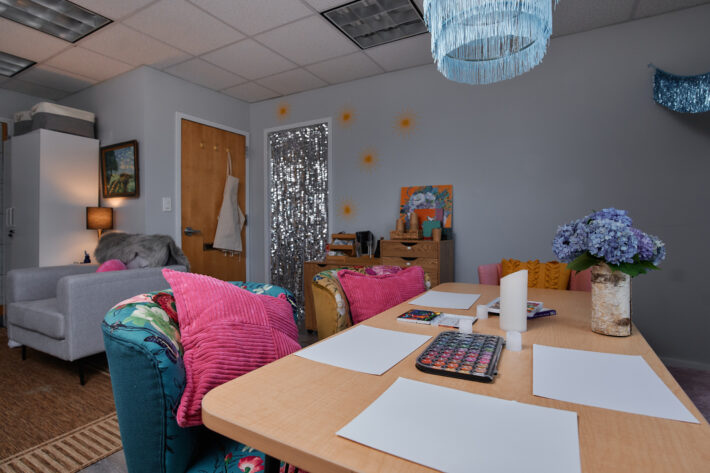
Upon arriving in the United States from Mexico at age 10, Sama Bajonero couldn’t have predicted that her seven-year struggle with depression would lead to suicidal thoughts by age 17.
“When I first moved here, I wanted to acclimate to the culture,” Bajonero said. “It was very hard for me because I was trying to fit into a mold that I wasn’t shaped for.”
Bajonero found it challenging to open up to non-Mexicans, and eventually stopped speaking with therapists at all.
Fortunately, years later, Bajonero discovered healing for herself through dance. “Dancing gives me an outlet for my depression,” she explained. “It has definitely made me love my identity even more.”
The Mayor’s Office annual report for 2023 unveiled that one in four New Yorkers experiences mental illness, with minorities being less likely to access care. As the city observed World Mental Health Day on October 10th, a new bill awaited the governor’s signature. This legislation would enable creative arts therapists to directly bill Medicaid, aiming to expand access to creative arts therapy, especially among immigrant communities grappling with language or cultural barriers in conventional therapy settings. Currently, there are over 2,000 licensed creative arts therapists across New York State.
Since spring 2022, over 210,000 migrants have arrived in New York City. In Midtown, the site of the city’s first arrival center for immigrants and where Councilman Erik Bottcher recently highlighted a mental health crisis, creative arts therapists are advocating for ways to make their services available to immigrants with urgent needs.
“Creative arts therapy is really effective for immigrants,” says Emily Davenport, founder and clinical director of Davenport Creative Arts Therapy. “It’s less confrontational and more approachable, even if the therapist doesn’t fully understand the client’s culture.”
A 2024 study by St. Mary’s College of Maryland found that creative arts therapy de-emphasizes verbal communication, making it particularly beneficial for people facing language barriers. “When we talk in therapy, we primarily use the prefrontal cortex of our brain,” Davenport explains. “But when we create art, we access entirely different parts of our brain. It’s crucial to utilize these various pathways, as we are multifaceted beings.”
In spite of its potential to address mental health issues within immigrant communities, creative arts therapy faces significant hurdles in reaching a wider audience.
“The cost of therapy is absolutely a burden,” said Marygrace Berberian, director of the Graduate Art Therapy Program at New York University. “People can receive creative art therapy in hospitals with insurance and get stabilized, but once they leave the hospital, they can’t afford a private therapist.” Berberian noted that the average cost of a creative art therapy session in New York is usually between 150 and 200 dollars.
Davenport’s center in Midtown often has to turn away Medicaid clients due to limited insurance coverage, noting that “Cigna is the only insurer that we can network with.” As of March 2024, over 4 million residents in New York City are enrolled in Medicaid.
“Creative arts therapy should really be accessible to more people, especially because it’s definitely lower-income communities that need it more than people who have a lot of money,” said Bajonero.
In response to this gap, Assemblyman Harry Bronson and Senator Samra Brouk sponsored Assembly Bill A9018, which would allow licensed creative arts therapists to bill Medicaid directly for their services. The LCAT Advocacy Coalition, established in 2022, is actively pushing for this legislation. Berberian notes, “The government has historically restricted access to creative arts therapies. We are advocating to increase access, especially for Medicaid recipients.”
Faced with the limited availability of licensed creative arts therapy, organizations like Keeping People Connected (KPC) and some independent artists are dedicated to using art as a means of healing for people from diverse cultural backgrounds.
“Dancing with KPC allows me to express myself and feel connected,” said Bajonero. “Through art, people’s stories are shared in ways that can’t be verbalized.”

“Painting and sharing means you are not facing problems alone,” said Yilun Zhan, a lighting designer and founder of Light Rabbit art healing studio in Midtown. “At the same time, the emotion expressed through art can be preserved.”
Despite the collaborative efforts of artists and licensed creative arts therapists, awareness and participation of this therapeutic approach remains low. “We’ve organized numerous free and low-cost therapy sessions, but engagement is minimal because people don’t understand what it is,” Davenport noted. Zhan concurs, saying, “Some people question if it’s more healing to spend money on a good meal.”
Assembly Bill A9018 passed both the Assembly and Senate in June and is now awaiting the governor’s signature. “More public dialogue about creative art therapy is needed,” said Berberian. “While we are hopeful about the bill, we need everyone’s support.”